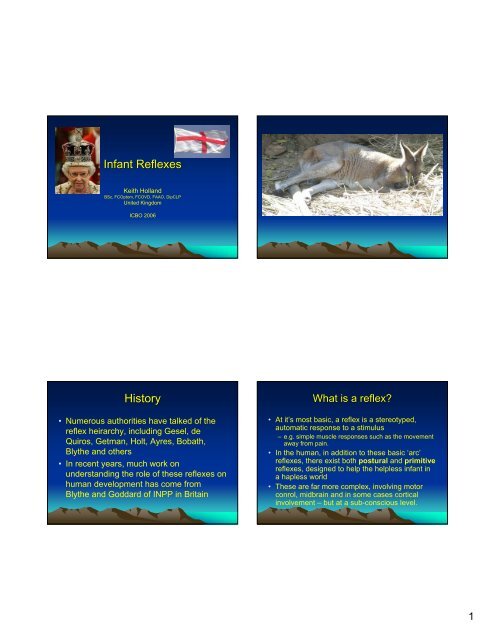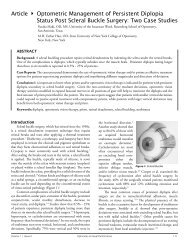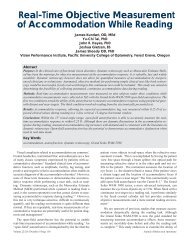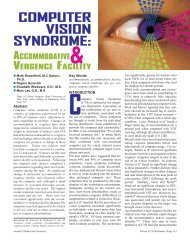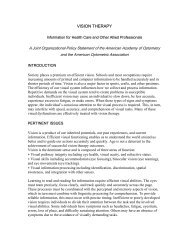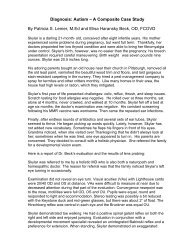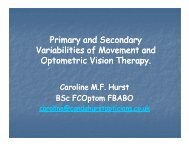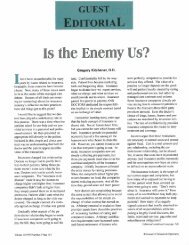Amphibian reflex - Optometric Extension Program Foundation
Amphibian reflex - Optometric Extension Program Foundation
Amphibian reflex - Optometric Extension Program Foundation
You also want an ePaper? Increase the reach of your titles
YUMPU automatically turns print PDFs into web optimized ePapers that Google loves.
Infant ReflexesKeith HollandBSc, FCOptom, FCOVD, FAAO, DipCLPUnited KingdomICBO 2006History• Numerous authorities have talked of the<strong>reflex</strong> heirarchy, including Gesel, deQuiros, Getman, Holt, Ayres, Bobath,Blythe and others• In recent years, much work onunderstanding the role of these <strong>reflex</strong>es onhuman development has come fromBlythe and Goddard of INPP in BritainWhat is a <strong>reflex</strong>?• At it’s most basic, a <strong>reflex</strong> is a stereotyped,automatic response to a stimulus– e.g. simple muscle responses such as the movementaway from pain.• In the human, in addition to these basic ‘arc’<strong>reflex</strong>es, there exist both postural and primitive<strong>reflex</strong>es, designed to help the helpless infant ina hapless world• These are far more complex, involving motorconrol, midbrain and in some cases corticalinvolvement – but at a sub-conscious level.1
Hierarchy of developmentFoetal First Year First Decade Adulthood||||| Motor roots|||||| Sensory roots||| Acoustic tectum||||Acoustic analyserFeldenstructure development||||Sub-cerebellum|||optic nerve & tract||optic radiations||||||mid-cerebellum||||||||||acoustic radiations|||||||||reticular formationThalamic|||| radiations||||||||||||||||| IntraCorticalassociationsPrimitive Reflexes• These are automatic, stereotypedmovements that are directed from thebrain-stem and executed without corticalinvolvement• Most are essential to survival– At least to effective survival• Primitive <strong>reflex</strong>es should ideally clear, ortransform into postural <strong>reflex</strong>es well beforeone year of ageAfter Robeck – The BrainPostural Reflexes• These are higher order automatedmovements, controlled by the mid-brain,indicating cortical involvement that allowssome voluntary inhibition of otherwise“automatic responses” to stimulus.STRUCTUREFUNCTION• They pave the way for the dependantinfant to become an independent adult3
SummaryKey <strong>reflex</strong>esConceptionLIFECellularDevelopment Reflex arcsAnd controlIn-uteroEarly lifePrimitive <strong>reflex</strong>esBrain Stem controlMid-brain control Postural <strong>reflex</strong>esCorticalcontrolMaturityAdultschema• Key Reflexes that relate to our work–MORO– Asymmetrical tonic neck <strong>reflex</strong>– Tonic neck <strong>reflex</strong>– Spinal gallant– Postural <strong>reflex</strong>es– Fear Paralysis ReflexMoroMoro• Possibly the most crucial device for kick startinglife in air• Any sudden stimulus causes instantaneousarousal of the organism• There is a sudden expansion of the lungs– Followed by a momentary pause or “freeze”– And then explosive exhalation, often with a cry– Immediately following, there is a stimulation of thesympathetic nervous system• That sympathetic system stimulation results in:– Release of adrenaline– Increased breathing rate (can cause hyperventilation)– Increased heart rate– Rise in blood pressure• This can all be accompanied by aggression /anger / excessive emotional outburst5
Moro• The <strong>reflex</strong> movement itself involves thearms flying out, with the fingers open,allowing the lungs to expand• The arms then pull in across the body,causing an exhalation, usually with a cryThus, we take our first breath of life…Moro• In early days, the Moro also acts as a means ofsummoning help to the helpless infant• It is like a panic alarm– All or nothing, and very ‘loud’• It can be initiated by a number of stimuli– Loud noise– Bright light– Sharp touch– Sharp change in balanceAuditoryVisualTactileVestibularMoro - in the longer term• The moro is usually emerging at about 11 weeksin utero, and is fully developed at birth• Ideally the Moro subsides by the third month• If not, the child becomes hypersensitive tosudden stimuli– They over-react– They may be emotionally over-sensitive– The constant release of adrenalin leads to draining ofcortisol supplies. In turn this lowers auto-immunedefences, and leaves them prone to minor infections• Sore throats, asthma and eczema are particularly common6
Moro – in the longer term– Visual effects include dilated pupils andphotosensitivity– The child may be constantly drawn to bright orsudden visual stimuli, leading to figure-groundproblems, and difficulty coping with detail– Auditory issues mirror vision• They overact to noise• They have difficulty coping with auditory discrimination• There is a specific hearing loss at 6,000HzMoro – the positive side• Yes, there really is one!• The Moro bound individual may be:-– Good at multi-tasking– Can go into ‘hyper-drive’ in emergencies– Can be good at ‘explosive’ type tasks, and may be anexcellent athlete (but not at the marathon!)– May like ‘living on the edge’, and be good at extremetype sports, or enjoys dangerAsymmetric Tonic Neck Reflex(ATNR)• If the moro helps us breathe: ATNR helpsus get out!• ATNR provides a corkscrewing action thathelps the head engage, and the baby topass down the birth canal, it is activatedby maternal contractionsATNRHead turn to the side(1)causes limb on thatside to extend (2), andopposite limb to pull in (3)–flexionA similar effect occurswith the legs (4)24137
ATNR• After birth, the ATNR helps ensure free airpassage in the early weeks, and laterhelps prepare the body for turning overand crawling– 3 for 1 What an economy of action!ATNR• Vision: In those crucial early days, ATNR helpsstimulate hand / eye correspondence,stimulating both vergence, version ANDaccommodation4 in 1!– (Remember the four circles?)• ATNR should clear by six months as it is nolonger needed• Almost always very strong in Cerebral Palsy• The down side of retention…ATNR – negatives• As we move to crawl, a retained ATNRblocks cross crawling– This blocks good bilateral integrationdevelopment– In turn, this may block myelination of corpuscallosum• Later, can effect walking causingipsilateral march and poor postural stabilityATNR – negatives• ATNR and writing…– As head turns toright, so right handpulls out to right– Tensionincreases, leadingto pressure, andbroken pencils8
ATNR – negatives• Some suggest affects development ofdominance• Visually, can ‘tether’ vergence to near(baby looks at hand all the time)– NPS & Myopia development?• May affect lateral pursuits, and laterimpact on readingOnly of use inAustralia- And if you are aKoala!ATNR – positivesTonic Neck Reflex (TLR)• Closely linked to the Moro• Controlled by vestibular system• Bending forward of neck causes folding ofarms & legs (forward TLR)• <strong>Extension</strong> of neck causes extension ofarms & legs (backward TLR)Forward TLRTLRBackward TLR9
TLR• TLR should be fully present by birth• Forward TLR should disappear by 4months• Backward TLR may take up to 3 years toinhibitTLR• Consider the forward TLR in terms offoetal position– And backwards TLR similar to MoroForward TLR(foetal position)TLRBackward TLR(Moro like)TLR – functions• As head control starts to develop, TLRallows ‘straightening out’ of body, ready formovement• Strengthens spinal control and muscletone• Crucial in developing ‘anti-gravity’ in thebaby10
TLR – retention effects• If not inhibited, TLR leaves us over-sensitive tovestibular stimulation• Head movement affects tone when standing• Can block normal crawling / creeping(don’t miss the next talk!)• Head rotations, balance and generalcoordination are all affected– In turn affecting oculomotor functions– And auditory functionsOneperson forwhom aTLR wouldbedisastrous!Symmetrical Tonic Neck Reflex(STNR)• Flexion of head causes arms to bend andlegs to extend• Only present for a very brief period• Helps us get up – therefore crucial tolocomotion11
STNRSTNR• Should appear at around 6-9 months of life• Should be transformed by 9-11 months• It is likely that STNR helps clear TLRthrough allowing head to stretch up,without legs flying out (counter effect toTLR)STNR – effects on vision• Whilst ATNR helps establish vergencecontrol at near• ATNR clears at 6 months, leaving infantfixed at far for a while• STNR then causes eyes to move back tonear when arms bent– And to far when straightened• Thus establishes near – far trainingSTNR• Pavlides and others have noted how manychildren with poor reading skills did notcrawl – and have poor near far skills• Have we been here before?12
STNR – effects on learning• A retainedSTNR will:– Affect posture,causingslumping overthe deskSTNR – effects on learning• A retained STNR may also –– Affect near / far switches– Affect ball control– Affect eating• As the STNR inhibits, we can truly movethe head independantly of the body andvestibular systems– We become free!Spinal GallantSpinal Gallant• Present in–utero• Clears by 3-9 months of life• Stimulation to one side of lower spine causesrotation towards side of stimulus13
Spinal Gallant• Function is rather obscure– May help birth process• Retention affects ability to sit down!– The “ants in the pants” child• Can affect bladder control (bed wetting)– Child may dislike tight waist bands & clothing• In adults, has been linked with IBS• Probably no direct effect on visionPostural Reflexes• As noted previously, each of the primitive<strong>reflex</strong>es should gradually mature and bereplaced by the relevant postural (or adult)<strong>reflex</strong>.• Generally this will occur between six months andeighteen months of age• The postural <strong>reflex</strong>es themselves should reducein the first three to four years - marking thematuration of the midbrain and higher corticalcentresPostural Reflexes• They include– Strauss <strong>reflex</strong> (successor to Moro)– Landau <strong>reflex</strong> (successor to STNR)– <strong>Amphibian</strong> <strong>reflex</strong> (successor to ATNR)– Oculo-head righting <strong>reflex</strong>– Labarynthine head righting <strong>reflex</strong>– Segmental rolling <strong>reflex</strong>esVisual system and <strong>reflex</strong>es• So what affects vision?• A recap..–Moro–ATNR–STNR–TLR14
Effect on visual system?MOROATNRBalanceYESYESVergenceYESYESAccommodationYESYESHeadcontrolYESEyeMovementsYES• There is one other <strong>reflex</strong> to consider• Even more basic than Moro• Known as The Fear Paralysis ReflexSTNRYESYESYESYESYESTLRYESYESYESYESYESFear Paralysis Reflex• The earliest ‘withdrawal’ from stress• An amoebic-like removal from danger• Present at 5-7 weeks post conception• Within days of initiation involves headpulling away & closure of eyes closelyimplicated in SIDSFear Paralysis Reflex• In the older child– Leads to a breakdown in visual control– Panic– Overt stress responses– Total loss of focus and vergence control– Denial of spatial understanding– I believe the FPR underpins StreffSyndrome15
Testing for <strong>reflex</strong>es• A series of well established tests exist toidentify the presence – and magnitude ofspecific <strong>reflex</strong>es• These are well documented in a number ofneurological texts• Most of us show some retention – it iswhere a cluster of retained <strong>reflex</strong>es existthat the fun startsTreatment of problems• Blythe & McGowan in the 1970’s and McPhillipsand Sheehey in the 1990’s, identified a series ofrepetitive movements made by infants at keypoints in their development• These movements appeared to have specificpurpose in that all infants studied made thesame movements• Following these movements, <strong>reflex</strong>es becameinhibitedTreatment• Several authorities have developed programmesto replicate these movements• They involve daily repetitive activities over abouttwelve months• Aim is to transform a cluster of primitive <strong>reflex</strong>esso they no longer pose a block to neurologicalmaturityVision Therapy and <strong>reflex</strong>es• BUT…– What do we do in V.T.?– How do our activities relate to the same repetitivemovements– Consider• Head rotations• Thumb rotations• Cross marching• Angels in the snow• …. And numerous other activities16
Other therapies• A number of groups and individuals haveproposed treatment programmes that helplearning difficulties. All have some impacton <strong>reflex</strong>es– OT & Sensory Integration– DORE / DDAT– Levinson– Dolman / DelacattoOur role as Behavioural Optometrists• Put simply…• To do whatever we can to alleviate factorsthat may inhibit the development ofefficient visual skills, and in so doing toenhance learning, personality and qualityof life for those we serveThank You!17


